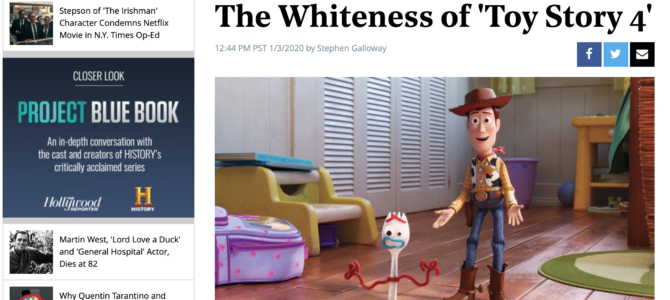
At times, the writing from entertainment outlets defies the definition of journalism even worse than CNN does. Right now we have a wave of writers outraged at Golden Globes host Ricky Gervais for saying mean things about celebrities. The press is now defending the One Percenters. Interesting.
It is commonplace to see a film critic imbue his movie reviews with personal political stances. To understand everything about entertainment journalism, all it takes is the realization that Harvey Weinstein was able to torment the movie business for years without so much as a media rebuke. Complicity is built into the business model. That is why the activism seen in print is not a surprise. Still, it is impossible to swallow as serious commentary.
To launch the new year in appropriately oblivious fashion, The Hollywood Reporter has an article out condemning ‘’Toy Story 4’’ for a litany of social transgressions. The outlet should be embarrassed over such content, but that emotion is in short supply in the business.
While the film was released more than six months ago, columnist Stephen Galloway just got around to writing on it. In that half-year stretch, he managed to find all manner of woke problems with the hit family film. According to Galloway, the movie is retrograde in content and so non-representative that it is hard to imagine anyone going to see this offensive Stepin Fetchit cartoon!
The obvious reaction is to note that anyone getting outraged over an animated feature is already worthy of scorn. But to be outraged over improper racial representation in a movie when its primary cast is not even human is risible. When presented with this kind of complaint, we are required to provide context.
A breakdown of the audience demographics is revealing. For “Toy Story 4,” the ticket buyer racial demographics were 49 percent Caucasian, 23 percent Hispanic, 12 percent African American, and 12 percent Asian. This is nearly in line with recent U.S. census figures, but with fewer whites and slightly higher Asians represented. This was the audience that drove the film to become the third highest-grossing movie of 2019, the best result in the film franchise.
The allegedly grievous racial portrayal also did not seem to affect foreign markets. “Toy Story 4’’ set the record for the highest opening ever for an animated film worldwide. So who exactly was offended by it? Besides Galloway, that is tough to sort out. But make no mistake, Stephen was very upset. Just some of the highlights from his tirade are below.
1. “Each of the leads is Caucasian, and not just the franchise regulars but a host of new ones including a very white fork (Tony Hale) that’s among the more memorable — and merchandisable — creations of this fourth iteration in the series.”
A plastic, machine-extruded eating utensil is now “Caucasian.” When this is the level you stoop to in order to come up with a social grievance, it is time to step away from the keyboard. Additionally, the character is actually a spork, so I believe Galloway is guilty of “othering” him.
2. “TS4’s main family lives in a big, brightly lit house in an ivory utopia…Problems of prejudice, money and unemployment never seem to cross anyone’s mind.”
It seems very odd but very apparent that Galloway needs to be alerted to the fact that this was a family movie aimed at children. Galloway seems to be the only person attending a “Toy Story’’ viewing expecting to see “Precious.”
3. “Not only is it unconnected to reality; it conveys the idea this is what reality should be.”
He is talking about the need for reality in a film about anthropomorphic children’s toys which can speak. I have an idea where the disconnect from reality is actually taking place.
4. “I’d have expected no less in the days when John Lasseter was running Pixar. Still, did nobody in the post-Lasseter era pipe up and say, ‘Hey! This has gotta change’?”
Lasseter saw his time at Pixar come to an end when he was caught up in Me Too accusations. Nothing about his tenure or departure had anything to do with race, nor the social inequities Galloway laments not being represented in a children’s animated lark.
5. “Take 2006’s Cars: its humor was based on all sorts of foreign stereotypes, inadvertently encouraging the anti-immigrant prejudice that’s now running rampant through the country.”
He is claiming the controversial Trump border policy was encouraged by a movie about talking automobiles. Who can forget those news segments about racist Immigration and Customs Enforcement agents quoting Larry The Cable Guy’s lines to members of the caravan from Honduras?
6. “Nor did previous Toy Story films do much to advance the times.”
What Galloway is trying to do is manipulate these movies to provide content that fits into his personal framework. Meanwhile these four “Toy Story” movies managed to gross more than $3 billion worldwide with their formula. It is safe to assume Disney/Pixar will not be consulting with Galloway on how to create a successful film franchise.
7. “If you’re white and middle-class…all this may seem moot. But not if you’re the five-year-old, African American girl a friend of mine recently adopted. I was about to give her Toy Story 4 but I’ve changed my mind. Because it sends the worst sort of message for a child like her: you’re an outsider, kept at a distance from everything fuzzy and fun in American life.”
I, too, am white, and middle-class. And I, too, found it difficult to say I was properly represented in this film, featuring a Canadian stunt motorcycle action figure, a 12-inch tall green dinosaur, and a plastic spork.
I find it far more difficult to adopt the mindset of writers like Galloway, for whom the most innocuous and non-threatening cinematic images are regarded as some type of social affront. If Galloway wants to talk about sending the worst messages, it would be teaching a five-year-old that the world is a ceaseless parade of social offenses over which she should be perpetually outraged.
Seeing toys coming to life on screen should inspire happiness and open imaginative possibilities. But Galloway wants to convey that everything in life generates sourness and social barricades. I guess his friend should expect him to gift his daughter with a Blu-Ray of the dour “Marriage Story’’ for her next birthday.









